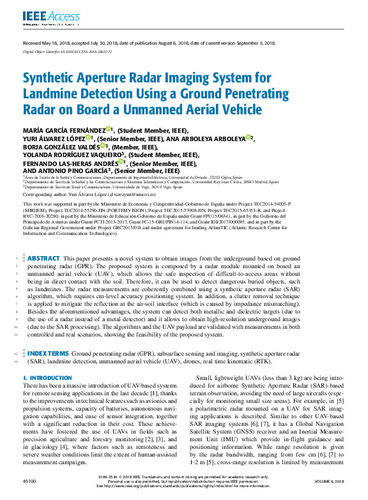Synthetic Aperture Radar Imaging System for Landmine Detection Using a Ground Penetrating Radar on Board a Unmanned Aerial Vehicle
Palabra(s) clave:
drones
imaging
UAV
georradar
minas antipersona
GPR
Fecha de publicación:
Editorial:
IEEE
Versión del editor:
Citación:
Descripción física:
Resumen:
This paper presents a novel system to obtain images from the underground based on ground penetrating radar (GPR). The proposed system is composed by a radar module mounted on board an unmanned aerial vehicle (UAV), which allows the safe inspection of dif cult-to-access areas without being in direct contact with the soil. Therefore, it can be used to detect dangerous buried objects, such as landmines. The radar measurements are coherently combined using a synthetic aperture radar (SAR) algorithm, which requires cm-level accuracy positioning system. In addition, a clutter removal technique is applied to mitigate the re ection at the air-soil interface (which is caused by impedance mismatching). Besides the aforementioned advantages, the system can detect both metallic and dielectric targets (due to the use of a radar instead of a metal detector) and it allows to obtain high-resolution underground images (due to the SAR processing). The algorithms and the UAV payload are validated with measurements in both controlled and real scenarios, showing the feasibility of the proposed system.
This paper presents a novel system to obtain images from the underground based on ground penetrating radar (GPR). The proposed system is composed by a radar module mounted on board an unmanned aerial vehicle (UAV), which allows the safe inspection of dif cult-to-access areas without being in direct contact with the soil. Therefore, it can be used to detect dangerous buried objects, such as landmines. The radar measurements are coherently combined using a synthetic aperture radar (SAR) algorithm, which requires cm-level accuracy positioning system. In addition, a clutter removal technique is applied to mitigate the re ection at the air-soil interface (which is caused by impedance mismatching). Besides the aforementioned advantages, the system can detect both metallic and dielectric targets (due to the use of a radar instead of a metal detector) and it allows to obtain high-resolution underground images (due to the SAR processing). The algorithms and the UAV payload are validated with measurements in both controlled and real scenarios, showing the feasibility of the proposed system.
ISSN:
Patrocinado por:
This work was supported in part by the Ministerio de Economía y Competitividad-Gobierno de España under Project TEC2014-54005-P (MIRIIEM), Project TEC2014-55290-JIN (PORTEMVISION), Project TEC2015-73908-JIN, Project TEC2015-65353-R, and Project RYC-2016-20280, in part by the Ministerio de Educación-Gobierno de España under Grant FPU15/06341, in part by the Gobierno del Principado de Asturias under Grant PCTI 2013-2017, Grant FC-15-GRUPIN14-114, and Grant IDI/2017/000095, and in part by the Galician Regional Government under Project GRC2015/018 and under agreement for funding AtlantTIC (Atlantic Research Center for Information and Communication Technologies). And by the Instituto Universitario de Tecnología Industrial de Asturias (IUTA).
Colecciones
Ficheros en el ítem




